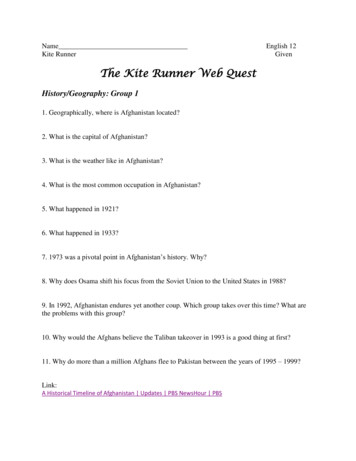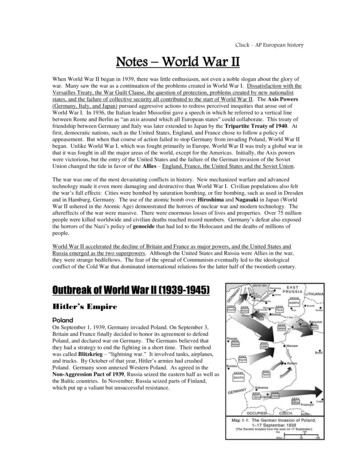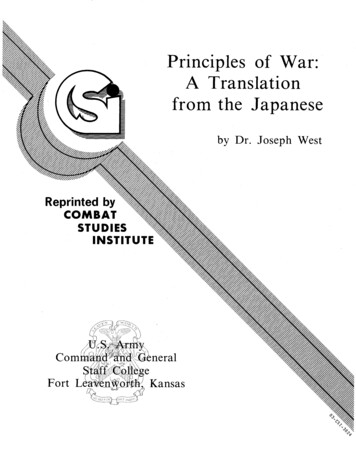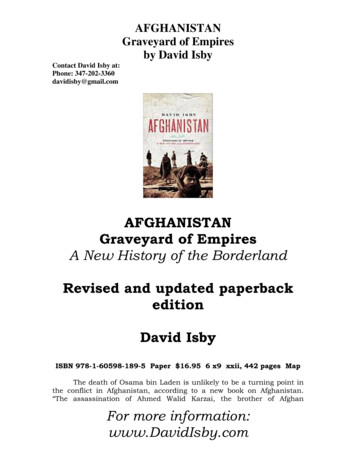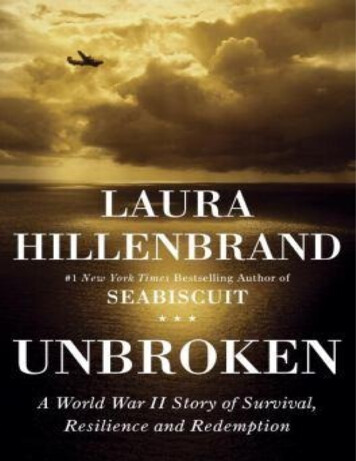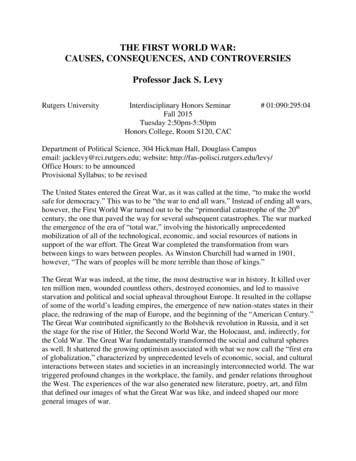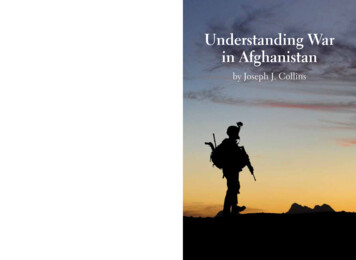
Transcription
Joseph Collins—a veteran Afghan watcher, National War College professor, and respectedstrategist—guides the reader expertly through the geography, history, and recent dynamicsof Afghanistan, providing a superb foundation for understanding the evolution of the efforthere. He concludes with a nuanced analysis of the current situation and considerations forconflict termination. Professor Collins’ book is an outstanding work for soldiers and diplomatsdeploying for their first tour in the shadow of the Hindu Kush; those with extensive time onthe ground will find the annotated bibliography full of excellent suggestions for further study.”—General David H. PetraeusCommanderInternational Security Assistance Force, Afghanistan“Understanding War in Afghanistan is an excellent book for journeyman students of Afghanistan.Understanding War in Afghanistan“Understanding War in Afghanistan is an excellent primer on a hugely complex conflict.Not only does it give them a summary of Afghanistan’s colorful geography and history, but italso presents an up-to-date picture of where the war is heading and an informed discussion ofthe range of choice for Afghanistan and its allies. This book is a great introduction to a difficultsubject, a must read for diplomats and military officers on their first tour in South Asia.”—Admiral James G. Stavridis, USN“Professor Collins has combined mastery of the Afghan experience and great strategic insightto produce the essential primer for the campaign in Afghanistan. His analysis clarifies thedynamics needed to develop options for this long campaign. His perspective establishesthe baseline needed by every American who will serve in Afghanistan or play a role in theexecution of future U.S. policy in that crucial region of the world.”—John R. Ballard, Ph.D.Dean of Faculty and Academic ProgramsNational War College“This is the required text for ‘Afghanistan 101’—a primer that skillfully explains the realitiesof a complicated country and America’s longest war. It is written in a clear, informative waythat is accessible to citizens, students, and civilian and military personnel who want or needto learn more about one of the most important issues of our time. Highly recommended.”—Dan CaldwellDistinguished Professor, Pepperdine UniversityAuthor of Vortex of Conflict: U.S. Policy Toward Afghanistan, Pakistan, and IraqCollinskey Afghan issues, the warfighting experiences of the major combatants, and the regionalUnderstanding Warin Afghanistanby Joseph J. Collins
Understanding Warin Afghanistan
Understanding Warin Afghanistanby Joseph J. CollinsNational Defense University PressWashington, D.C.2011
Opinions, conclusions, and recommendations expressed or impliedwithin are solely those of the contributors and do not necessarily represent the views of the Defense Department or any other agency of theFederal Government. Cleared for public release; distribution unlimited.Portions of this work may be quoted or reprinted without permission,provided that a standard source credit line is included. NDU Presswould appreciate a courtesy copy of reprints or reviews.Library of Congress Cataloging-in-Publication DataCollins, Joseph J.Understanding war in Afghanistan / by Joseph J. Collins.p. cm.Includes bibliographical references.1. Afghan War, 2001- 2. Afghan War, 2001---Causes. 3.Afghanistan--History--1989-2001. I. Title.DS371.412.C65 2011958.104’7--dc232011017235First printing, June 2011NDU Press publications are sold by the U.S. Government PrintingOffice. For ordering information, call (202) 512–1800 or write to theSuperintendent of Documents, U.S. Government Printing Office,Washington, D.C. 20402. For the U.S. Government On-Line Bookstorego to: http://bookstore.gpo.gov.
ContentsOpening Thoughts. . . . . . . . . . . . . . . . . . . . . . . . . . . . . . . . . . . . . . . . viiPreface . . . . . . . . . . . . . . . . . . . . . . . . . . . . . . . . . . . . . . . . . . . . . . . . . . ixMaps. . . . . . . . . . . . . . . . . . . . . . . . . . . . . . . . . . . . . . . . . . . . . . . . . . . xiiiIntroduction. . . . . . . . . . . . . . . . . . . . . . . . . . . . . . . . . . . . . . . . . . . . . . 1ChaptersLand, People, and Culture . . . . . . . . . . . . . . . . . . . . . . . . . . . . 512 The Struggle for Independence, Modernization,and Development . . . . . . . . . . . . . . . . . . . . . . . . . . . . . . . . . . 153 TheSaur “Revolution” and theSoviet-Afghan War, 1978–1989 . . . . . . . . . . . . . . . . . . . . . . . 254 Civil War and Advent of the Taliban. . . . . . . . . . . . . . . . . . . . 355 9/11 and the War Against the Taliban Government. . . . . . . 456Insurgency: Theory and Practice. . . . . . . . . . . . . . . . . . . . . . . 537 TheSecond War Against the Taliban and the Struggle toRebuild Afghanistan. . . . . . . . . . . . . . . . . . . . . . . . . . . . . . . . 638The Surge . . . . . . . . . . . . . . . . . . . . . . . . . . . . . . . . . . . . . . . . 819A Current Assessment and Contending Options . . . . . . . . . . 8910Conclusion . . . . . . . . . . . . . . . . . . . . . . . . . . . . . . . . . . . . . . 111Suggestions for Further Reading . . . . . . . . . . . . . . . . . . . . . . . . . . . . 115Notes. . . . . . . . . . . . . . . . . . . . . . . . . . . . . . . . . . . . . . . . . . . . . . . . . . 121About the Author . . . . . . . . . . . . . . . . . . . . . . . . . . . . . . . . . . . . . . . . 137v
Opening ThoughtsAs we confront [future] decisions, it is well to remember what is atstake. If we fail in Afghanistan, the state will fragment; there is no powercenter yet standing on its feet and capable of taking our place. If Afghanistanfragments, then parts of the country will again become the natural base forthose who have attacked not only us but also London and Madrid and whohave planned to blow up planes over the Atlantic. And a fragmented Afghanistan will become the strategic rear and base for extremism in Pakistan,a nation of 155 million people that is armed with nuclear weapons. Thiswill allow and facilitate support for extremist movements across the hugeswath of energy-rich Central Asia, as was the case in the 1990s.—Ambassador Ronald E. Neumann, The Other War: Winningand Losing in Afghanistan1Similarly, a setback in Afghanistan would be enormously empowering to jihadists everywhere in the world but would also inflict enormousreputational damage on the United States (as the perception of U.S.failure in Iraq in 2003–2006 did). Failure after the President recommitted the United States to succeed in Afghanistan would support thenotion that America is incapable of capitalizing on its military power andadvantages (including the development of an extremely capable forcefor conducting counterinsurgency operations). It would make dealingwith potential problems in Pakistan, Yemen, and Somalia (to name afew) enormously harder.—Ambassador Eric Edelman, Understanding America’sContested Primacy2vii
PrefaceThis monograph is an intellectual primer on war in Afghanistan. Icome to this task through a string of accidents that has kept me involvedwith war in Afghanistan as a Soldier and an academic for over 30 years.It began in graduate school at Columbia University in New York City,where I was privileged to study with some of the Nation’s greatest expertson the Soviet Union and Central Europe, and with another superb crewof scholars on war and peace issues. These interests came together withthe Soviet invasion of Afghanistan.From 1980 to 1984, I worked on my dissertation on the Soviet invasion under the guidance of two consummate professionals: ProfessorsMarshall Shulman, the former Advisor to Secretary of State Cyrus Vanceon Soviet affairs; and Zalmay Khalilzad, a young academic strategist wholater became a colleague in the Pentagon and still later Ambassador toAfghanistan, his boyhood home, and then to Iraq. Three colleagues atWest Point were very helpful in my study of Afghanistan: then-ColonelTy Cobb, my boss, and a future senior director on the National SecurityCouncil (NSC) staff; Visiting Professor Jerry Hudson, a superb Sovietexpert and a demanding coach; and the late Louis Dupree, the world’sleading Afghanistan specialist, a scholar with a soldier’s heart. David Isbyand Bill Olson have also been friends and tutors on Southwest Asia since1980. My former student and Army colleague Tom Lynch has joined theirranks and has been especially helpful on the issue of modern-day Pakistan.Sadly, a few years after leaving Columbia and my concurrent teaching tour in the Department of Social Sciences at West Point, I watchedthe Afghan war with the Soviet Union end, only to be replaced by acivil war, then a war against the Taliban, and then a war prosecuted byix
Understanding War in Afghanistanthe Taliban and al Qaeda against the Northern Alliance. As a result ofthis endless war, Afghanistan has become one of the most devastatedcountries on Earth.In 2001, as Deputy Assistant Secretary of Defense for Stability Operations (2001–2004), I was privileged to lead a team of Pentagon policyexperts who worked a key part of the Pentagon’s Afghanistan portfolio.Inside the Pentagon, we took our orders from Under Secretary DougFeith and worked closely with his deputy, Bill Luti, and later the DefenseDepartment’s senior reconstruction and stabilization coordinator DovZakheim, the department’s comptroller. My team interacted with an active and productive interagency effort led by Ambassador Bill Taylor, andlater the NSC staff’s Tony Harriman. In my seven trips to the region, thedevastation of the country and the difficulty of counterinsurgency stoodout starkly. On my last trip, I flew home next to the gurney of a severelywounded paratrooper from the Alaska-based 4th Brigade Combat Team(Airborne) of 25th Infantry Division. The severity of his wounds and thedevotion of his Air Force medics were vivid reminders of the costs of thiswar and the continuing sacrifice of our men and women in uniform.I returned to academic life in 2004 and now teach at the NationalWar College, where I have been engaged in a full-time study of war onthe low end of the conflict spectrum. Teaching remains the ultimatelearning experience, and this monograph owes much to the intellectualstimulation my students provide. It could not have come about withoutthe help of many people. I would like to thank Vice Admiral Ann Rondeau, USN, President of the National Defense University, and MajorGeneral Robert Steel, USAF, then-Commandant of the National WarCollege, for allowing me a sabbatical to complete this and other projects. My colleagues, Dan Caldwell of Pepperdine University; Jacquelinex
PrefaceHazelton of Harvard University’s Belfer Center; Daniel Weggeland, aveteran of service in Afghanistan on the development and counterinsurgency fronts; Colonel Vince Dreyer, USA, an Afghanistan veteran turnedacademic expert; former Ambassador Ron Neumann; Jeff Hayes of theNSC staff; and Lieutenant Colonel Jason Boehm, USMC, of the JointStaff, and Liz Packard of U.S. Central Command read the manuscriptand made great suggestions. Special thanks go to Admiral James Stavridis,Supreme Allied Commander Europe. He, Colonel Mike Howard, USA,and others at Supreme Headquarters Allied Powers Europe made manyinsightful comments on the manuscript. General Peter Chiarelli, theVice Chief of Staff of the Army, and Lieutenant General Chuck Jacoby,the Joint Staff, J5, were supportive throughout. As always, the creativeteam at NDU Press added immeasurably to the final product.My wife Anita, along with my sons Joseph and Jude and their families, are my life and my moral support. They join me in dedicatingthis monograph to the military personnel, diplomats, and civil servantswho have served in Iraq and Afghanistan. To paraphrase Sir WinstonChurchill, as we approach the 10th anniversary of 9/11, never have somany Americans owed so much to so few of their countrymen. As always,despite all of this support and assistance, any mistakes in this monographare my own.xi
xiiiAfghanistanLAMBERT CONFORMAL CONIC PROJECTION; STANDARD PARALLELS 30 25'N37 10'N803281Al (G00878)1-08
xvPhysiographyLAMBERT CONFORMAL CONIC PROJECTION; STANDARD PARALLELS 30 25'N37 10'N803282Al (G00878)1-08
xviiAdministrative DivisionsLAMBERT CONFORMAL CONIC PROJECTION; STANDARD PARALLELS 30 25'N37 10'N803283Al (G00878)1-08
Ethnolinguistic Groups802551 (R00434)6-97xix
IntroductionThis monograph aims to provide military leaders, civil servants, diplomats, and students with the intellectual basis they need to prepare forfurther study or for assignments in Afghanistan, a nation that has been atwar for 33 years. Officers in the Af-Pak Hands Program may also find ita useful starting point, but their intensive studies will quickly take thembeyond the scope of this work. Students or scholars may also find it auseful primer for learning about Afghanistan. By analyzing the land andits people, recapping Afghan history, and assessing the current situation,this work hopes to set a foundation upon which leaders and scholars canbegin their preparation for more specific tasks. It also will examine therange of choice for future U.S. policy toward Afghanistan and give suggestions for future study.Much of the outline of recent events will be familiar to many readers. Just 2 days before their 9/11 attack on the United States, al Qaedaoperatives posing as journalists succeeded in assassinating the commander of Northern Alliance forces, Ahmed Shah Massoud, inside his ownheadquarters in northern Afghanistan. This act was an al Qaeda favor toits Taliban brothers, a reward for their past support, and a down paymenton the grief that was about to descend on the Taliban from the UnitedStates and its allies. With the heinous terrorist acts of 9/9 and 9/11, theAfghan and American people became tied together in a common waragainst al Qaeda and its fellow traveler, the Taliban.After al Qaeda bombed our Embassies in Kenya and Tanzaniain 1998, the United States, the Kingdom of Saudi Arabia, and othersasked the Taliban to surrender Osama bin Laden. They refused. After1
Understanding War in Afghanistanal Qaeda’s attacks on New York, the Pentagon, and in Pennsylvania, theTaliban again refused to turn over Osama bin Laden and his accomplices. With the backing of its allies and a United Nations (UN) Security Council Resolution, the United States took decisive action. WithSpecial Operations Forces (SOF), CIA operatives, and U.S. airpower insupport, the Northern Alliance and friendly Pashtun tribes in the southwere able to vanquish the Taliban forces and chase them and their alQaeda allies into Iran and Pakistan. Sadly, both Mullah Omar andOsama bin Laden escaped along with many of their key subordinates.An international conference established an interim government withNorthern Alliance and anti-Taliban Pashtun representatives. HamidKarzai was named its interim leader.The initial phases of Operation Enduring Freedom (OEF) in Afghanistan were successful but not decisive. From 2002 to 2005, a smallAmerican and international force tried to help Afghanistan to its feet.There was modest and mainly unopposed progress in development,governance, and the rule of law. With a “small footprint” force and notvery much aid money, efforts by the Kabul government and its partnerswere not enough. The Taliban plotted a comeback and made detailedpreparations from its sanctuary in Pakistan. With a priority on operationsin Iraq, the United States was surprised at the virulence of the Talibanattack that began in earnest in 2005. India attempted to offset Pakistaniinfluence through aid and economic policy. Iran tried hard to protectits interests in the west, and erratically aided the Taliban—its former enemy—in order to block the United States. China and Russia looked onwarily, often seeking economic benefits. The Kingdom of Saudi Arabialater tried to help make peace but was frustrated by the links between theTaliban and the Kingdom’s mortal enemy, al Qaeda.2
IntroductionOnly in 2008, however, after the war in Iraq began to subside, wasthe United States able to focus on its serious predicament in Afghanistan. The Obama administration redoubled U.S. efforts, stepped updrone attacks against insurgent and terrorist leaders, and surged U.S.civilian and military assets in hopes of bringing about conditions conducive to peace. At the same time, President Barack Obama declaredthat he would not support an endless war in Afghanistan. He noted hisintention to begin a conditions-based withdrawal of American forces inthe summer of 2011. Later, the NATO nations at the Lisbon Summitestablished a target date of 2014 for Afghanistan to take charge of itssecurity nationwide.How did the United States and its allies get to where they are today?How can that coalition understand the many wars in Afghanistan overthe past 33 years? How should it define its interests today? How can thisgroup of nearly 50 nations—working together as the International Security Assistance Force (ISAF)—help to bring this war to an end? To answerthese questions, it is important to first examine the land, its people, andtheir culture (chapter 1). Next, we have to grapple with Afghan history(chapter 2), the Soviet-Afghan War (chapter 3), and the conflicts that followed it (chapters 4 and 5). As we move to the current conflict, we mustalso understand the basic theory and concepts that underpin counterinsurgency in the 21st century (chapter 6). This enables us to comprehendwhat happened during the 2002–2010 timeframe (chapters 7 and 8).Finally, we have to examine the potential choices that national leadersface for the future (chapter 9). Throughout the text, I draw heavily onmy own published work with minimal citations.1 The data in this studyare the best available in January 2011.3
1. Land, People, and CultureGeography, demography, and culture are among the great “givens”of life. They can influence every aspect of our existence. Knowing aboutthem is the first step in learning about a state, its peoples, and its policies.Afghanistan is slightly smaller than Texas, roughly 647,500 squarekilometers. Looking at the map, its most dominant feature is the HinduKush mountains, which rise to 7,485 meters and cover all but the northcentral and southwest portions of the country.1 Even Kabul, the capital, lies at 1,789 meters in elevation. Semi-desert terrain is common inthe south and west and in the flatter areas. Snow melt and a handfulof rivers, aided by intricate and sometimes ancient irrigation systems,bring water to farmland in many regions. Only 14 percent of the land isarable, a great limitation since farming and herding are the most common occupations. Afghanistan has as much as 1 trillion to 3 trillionin mineral wealth, much of which was recently rediscovered and notyet exploited.2Politically, Afghanistan today has an external border with Pakistanmeasuring 2,430 kilometers (km), disputed since it was drawn by theBritish along the Durand Line in 1893. It also has a border in the westwith Iran measuring 936 km as well as significant borders with the formerSoviet republics and now independent nations of Turkmenistan (744km), Uzbekistan (137 km), and Tajikistan (1,206 km). There is also ashort border with China (76 km) in the mountainous, sparsely populatedWakhan Corridor in the northeast. Internally, Afghanistan is divided into34 provinces, which are subdivided into nearly 400 districts. Afghanistanhas a poor nationwide transportation network. A primary road, oftenreferred to as the Ring Road, connects the major cities: Kabul in the5
Understanding War in Afghanistaneast, Kandahar in the south, Herat in the west, and Mazar-i-Sharif inthe north. It was built with U.S. and Soviet help in the 1960s and rebuiltby the United States, its coalition partners, and international financialinstitutions (IFIs) after 2001. Other primary roads connect Kabul to Jalalabad in the east, not far from the Pakistan border. Another major roadruns from Kandahar in the south to the Chaman crossing, and then intothe Baluchistan Province of Pakistan. To compete with the Pakistanigeographic advantage, India and Iran have also built new roads, one ofwhich runs north from the Iranian port of Charbahar into the provinceof Nimruz in Afghanistan, ultimately linking up with the Ring Road inDelaram. Another Iranian-built road connects Islam Qala with Herat inwestern Afghanistan. Thousands of kilometers of secondary and tertiaryroads have been built by allied forces, supporting aid agencies, and IFIs.American generals and diplomats generally agree with the pithy observation of the current Ambassador and former commanding general, KarlEikenberry: “Where the roads end, the Taliban begins.”3Air and rail assets present a contrast. Air travel is fairly well developed for such a poor country. There are major airports in Kabul, at theBagram military facility north of Kabul, and in Kandahar. Mazar-i-Sharifis the logistic hub to the north, and Jalalabad in the east, and Herat andShindand in the far west, also have airports. There are only 75 km ofrailroad, connecting the north to Uzbekistan.The population of Afghanistan is uncertain, but most experts believeit to be in the range of 28–30 million people. Despite substantial repatriation, more than two million Afghans remain refugees in Iran and Pakistan.The population is young, with 44.6 percent under the age of 15 years.The relatively high growth rate of 2.6 percent is moderated by some of thehighest infant and child mortality rates in the world. Life expectancy is 446
Land, People, and Cultureyears. Less than 25 percent of Afghans live in urban areas compared to 67percent of Iraqis. By definition, reconstruction or construction in Afghanistan will be about rural areas, which are some of the least developed inthe world. On the UN Human Development Index, which measures thehealth, education, and economic life of a nation, Afghanistan has beenconsistently ranked in the bottom 10 countries in the world.Afghanistan is a multiethnic Muslim state. The most dominantgroup is the Pashtuns (also called Pathans, Pushtuns, or Pakhtoons),estimated at 40–42 percent of the population. There may be as manyas 400 tribes and clans of Pashtuns, although the war, refugee life, andthe Taliban have subverted the power of tribal and clan leaders. ThePashtuns tend to live in the eastern and southern parts of the country,but pockets of Pashtuns can be found in the north. While there are approximately 12 million Pashtuns in Afghanistan, there are twice as manyin Pakistan, mainly in the eastern parts, in Khyber Pakhtunkhwa (theformer Northwest Frontier Province), the Federally Administered TribalAreas (FATA), Baluchistan, and around Karachi. The 2,400 km borderbetween Pakistan and Afghanistan is often ignored by Pashtun tribes living near it. Inside Afghanistan, perhaps the greatest intra-Pashtun faultline is between southern or Durrani Pashtuns and the eastern or GhilzaiPashtuns. Inside Pakistan, tensions between Islamabad and the semiautonomous tribes are constant. The Pashtun tribes in the FATA of Pakistanand elsewhere have formed their own insurgent groups in recent years,the most notable of which is the Tehrik-e-Taliban Pakistan.4The other major Afghan groups are the Tajiks at 27–30 percent, theHazara at 15 percent, and the Uzbek and Turkmen at 9–10 percent of thetotal population. The remaining 13 percent or so come from smaller minorities: Nuristani, Pashai, Aimaq, and others. Languages are also mixed,7
Understanding War in Afghanistanwith about half speaking Dari (Afghan Persian, the lingua franca); 35percent speaking Pashto (or Pushtu, the language of the Pashtun); and11 percent—mostly Uzbek and Turkmen—speaking Turkic languages.There are 30 known minor languages also spoken in Afghanistan.Three groups dominate the non-Pashtun segment of Afghans. Together, they constitute a majority of the population. The Dari-speakingTajiks are the second largest group. They are nontribal and dominatethe populations of Kabul, Mazar-i-Sharif, and Herat. Most nonurbanTajiks are spread across the northeastern part of the country includingthe famous Panjshir Valley. While most Tajiks are farmers, they have“historically been the bedrock of the merchant community, bureaucrats,and educated clergy” in Afghanistan.5 Many analysts believed that theTajik formations under the late Commander Ahmed Shah Massoud werethe most effective fighters in the anti-Soviet war. They formed the coreof the Northern Alliance that retook Kabul in the fall of 2001.The Hazaras, the next largest group, live mainly in the central highplateau and in the north. Many of them have distinctive Mongol-likefeatures. Because of their appearance and the fact that most Hazaras areShia Muslims, they have often been treated badly by other Afghans, withthe Taliban being the last to mistreat them. For most of the modern era,aside from the Taliban period of rule, the Sunni-Shia schism has notbeen as divisive a factor in Afghanistan as it has been in Iraq.The Turkic-speaking Uzbeks and Turkmen make up 10 percent ofthe Afghan population. Many Uzbek and Turkmen families moved fromtheir non-Afghan homelands in Central Asia in the 20th century when theBolsheviks took over all of the republics of the then–Soviet Union. The Uzbeks and Turkmen are famous for carpets and karakul sheep. The Uzbeksare considered highly effective fighters on the ground or on horseback.8
Land, People, and CultureMost Afghans (not “Afghanis,” which refers to the local currency andis considered by some Afghans as bad form if used to refer to people) areSunni Muslims (80 percent), with the balance—mainly Hazaras—beingShia Muslims. Prior to the Soviet invasion of 1979, many observers sawAfghans as rather laid-back Muslims. Tribal ways that run counter toIslam may still hold sway in a few isolated areas. Pashtuns are defined bytheir tribes and their folkways. As noted, however, these tribal structureshave been severely stressed by wars. Many who grew up in Pakistani refugee camps lost track of their tribal roots, leaving them much more opento the influence of religious figures, called mullahs, and other nontriballeaders. In all, the strict observance of Islam has grown across Afghanistansince the war with the Soviet Union.Since the Pashtuns dominate the nation’s leadership as well as thatof the Taliban, it is important to delve deeper into their culture. Pashtunculture revolves around the Pashtunwali, their pre-Islamic code of honor.It emphasizes honor, hospitality, protection of women, and revenge. Louis Dupree, the late eminent Western specialist on Afghanistan, describedthe Pashtunwali this way:to avenge blood to fight to the death for a person who has taken refuge with meno matter what his lineageto defend to the last any property entrusted to meto be hospitable and provide for the safety of guests to refrain from killing a woman, a Hindu, a minstrel, or a boynot yet circumcised to pardon an offense on the intercession of a woman of theoffender’s lineage, a Sayyid, or a Mullah9
Understanding War in Afghanistanto punish all adulterers with death to refrain from killing a man who has entered a mosque or ashrine of a holy man . . . also to spare the life of a man whobegs for quarter in battle.6Pashtun culture has helped to keep Afghanistan independent, butit has also helped to make it a fractious place, rife with internal violencewithin and between families and clans. Even conflict between cousins is athread in all too many stories in this part of the world. Pashtuns, however,have a tradition of tribal assemblies, or jirgas, that help them to resolveproblems and make group decisions. The term shura, an Arabic expressionmeaning consultation, is also used to denote smaller consultative groupings. On a few occasions, the entire Afghan nation has formed a grandassembly, a loya jirga, to approve a constitution or select a national leader.Xenophobia is another aspect of Afghan culture. Throughout Afghanistan, suspicion of foreigners is strong. This no doubt stems from insularity and frequent invasions. Afghans are independence-minded. ThePashtun warning to the government and to foreigners says it all: don’ttouch our women, our treasure, or our land. Non-Pashtun Afghans—58percent of the population—generally share this attitude and have theirown set of hard feelings toward the dominant Pashtuns. Afghans of allstripes have a strong sense of personal and national honor.The Pashtuns form the largest group of Afghans and account fornearly all of today’s insurgents inside the country. The Taliban (literally“students”) started as an organized group in 1994. Although led by Afghan Pashtuns, Pakistan has supported the movement from the outset.The Taliban’s roots reach back to the war with the Soviets and to therefugee Islamic school madrassa (madaris in the plural form) found in10
Land, People, and CulturePakistan and in the countryside of southern Afghanistan. Often fundedby Muslim charities from the Gulf, these madaris were rudimentaryreligious schools, but they were among the few schools of any sort thatwere open to Afghans or Afghan refugees during the civil war. The mullahs also fed and often housed their pupils. In these schools, countrymullahs taught their often illiterate students to memorize the Koranand the hadith—the sayings of the Prophet. The students also learnedto revere the conduct of jihad as holy war and observe the pure practicesof the original Islam.Many students became religious zealots, dedicated, honest, andwithout much to lose. Their beliefs were anti-Western and antimaterialist and favored old-time Islam, thus closely paralleling what Salafistspreached. Ahmed Rashid, a Pakistani scholar-journalist, saw the Talibanthis way:These boys were from a generation that had never seen their country at peace. . . . They had no memories of their tribes, the
strategist—guides the reader expertly through the geography, history, and recent dynamics . “Understanding War in Afghanistan is an excellent book for journeyman students of Afghanistan. Not only does it give them a summar


